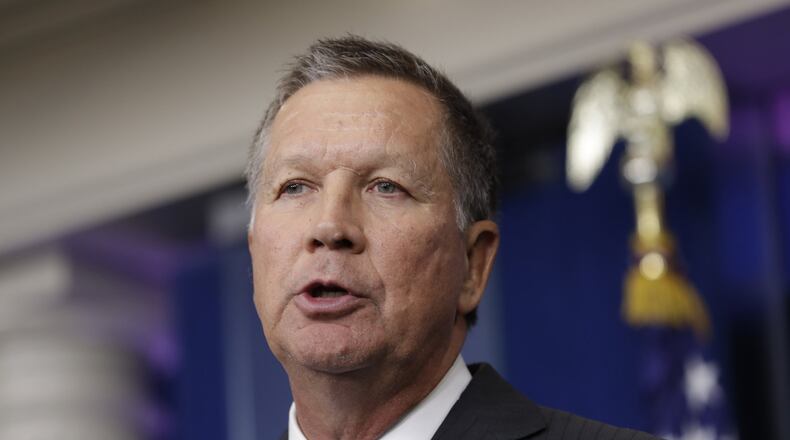RELATED: KASICH DOES NOT JOIN TRUMP EVENT
Kasich’s warning stems mainly from state tax collection data that show receipts coming in under expectations. Figures from the Ohio Office of Budget and Management show tax receipts so far this fiscal year are down 1.2 percent from last year, and the nearly $1.9 billion in tax receipts collected in November were $99 million — or 5 percent — below projections.
“The future is going to be tough,” Kasich said during a speech to the Ohio House early last month. “We are on the verge of recession in our state.”
To be sure, declining tax revenues could lead to cuts in spending on public goods and services and result in declining public payrolls, throwing cold water on a still sluggish recovery from the last recession. But such leading economic indicators as employment, industrial production, retail sales and real personal income continue to grow in Ohio, albeit at a tepid pace.
“We have a weak economy…we’re not in recession,” said Wendy Patton, a policy analyst with the left-leaning think-tank Policy Matters Ohio, who places the blame for such sluggish growth and fears of recession squarely at the feet of Gov. Kasich.
RELATED: MANY WORKING AGE MEN SIMPLY DON’T WANT TO WORK
“The tax revenue shortfalls can be attributed to the big tax cuts that have been going on in Ohio really since 2005 and have accelerated under the Kasich administration,” according to Patton, who said such tax polices have cut $3 billion a year from state revenues over the past decade. “If you cut taxes deeply enough, and you gut them on the growth component of the economy, which is top earners, your revenues are going to sag. These are not good signs, but they don’t necessarily indicate a sudden change in the economy like a recession.”
Patton noted that Ohio is just one of many states that have seen tax collections slide, but that hasn’t brought the national economy to a halt.
RELATED: FED RATE INCREASE SLOWS DOWN DOW’S MARCH TO 20,000
In fact, U.S. gross domestic product grew at its fastest rate in two years during the three months ended in September, climbing at a revised 3.5 percent annualized rate — slightly above economists’ consensus estimates of a 3.3 percent gain, according to the Bureau of Economic Analysis.
That, despite a decline in national real total state tax revenue, which decreased 0.1 percent for the year ending in the third quarter of 2016 on an inflation-adjusted basis, compared with one year earlier. This was the first quarter that real national state tax revenue declined since the second quarter of 2010, according to U.S. Census Bureau figures compiled by the Washington, D.C.-based Urban Institute.
RELATED: METAL THEFTS DOWN IN OHIO
In Ohio, GDP was up 1.9 percent over the same period, while real total state tax revenue decreased 1.6 percent, according to the report.
But GDP statistics are not a reliable indicator of economic growth or stagnation in future quarters. And Lawson noted that fiscal conditions can change rapidly in Ohio, which “has tended to get into recessions a little bit earlier than some other states and stay in recession longer.”
The trend underscores some of the longstanding structural problems with the state’s economy, including the decades-long decline in manufacturing jobs and stagnant population growth, he said: “This isn’t a new phenomenon. There’s been something not quite right about Ohio for a long time.”
Still, fiscal conditions have improved dramatically since the Great Recession ended more than seven years ago, which has been reflected in slow but steady job growth that actually picked up steam last month.
Employers statewide added 9,100 jobs in November — the most recent month for which figures are available — while the unemployment rate remained unchanged from October at 4.9 percent, according to the figures from U.S. Bureau of Labor Statistics.
Ohio's rate was just slightly higher than the national jobless rate, which hit a nine-year low of 4.6 percent in November as the U.S. economy added 178,000 jobs, BLS figures show.
In the Dayton area, the local economy continues on the path of robust recovery, led by local and international manufacturers, such as Fuyao Glass America, bringing jobs to the area, continued investment in the aerospace and IT industries and unprecedented growth in the metro area’s large health care sector, according to Chris Kershner, vice president for economic development at the Dayton Area Chamber of Commerce.
“There are some things happening in the Dayton region that may give us a brighter economic outlook than some other parts of the state,” Kershner said, noting that the most recent figures show the Dayton region added 6,800 jobs through October, compared to the same period a year ago, and the unemployment rate was 4.5 percent.
“Our unemployment is lower than the state and lower than the nation, which to me that’s a sign of economic growth, not a correction,” he said. “And we’ve got businesses that are continuing to invest and grow in the Dayton area, and that business investment is the strongest economic indicator.”
About the Author
